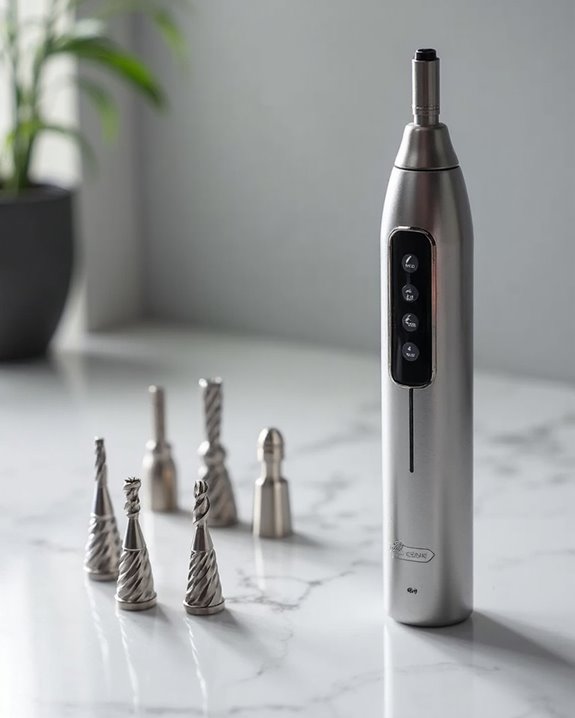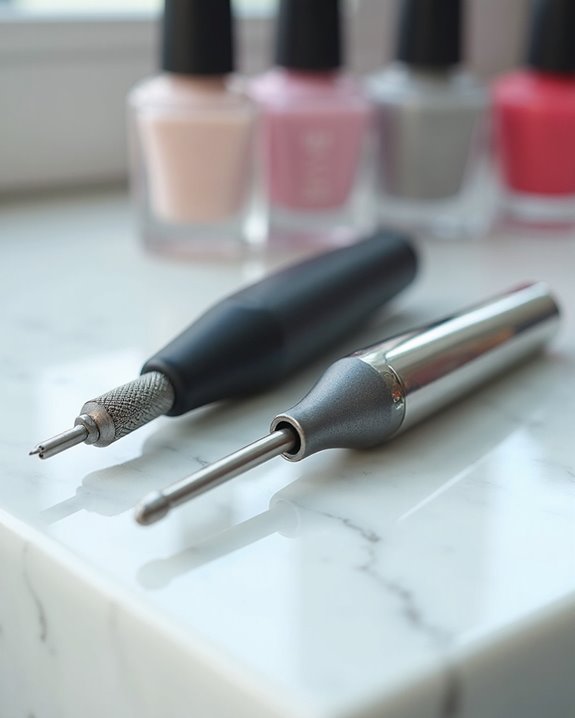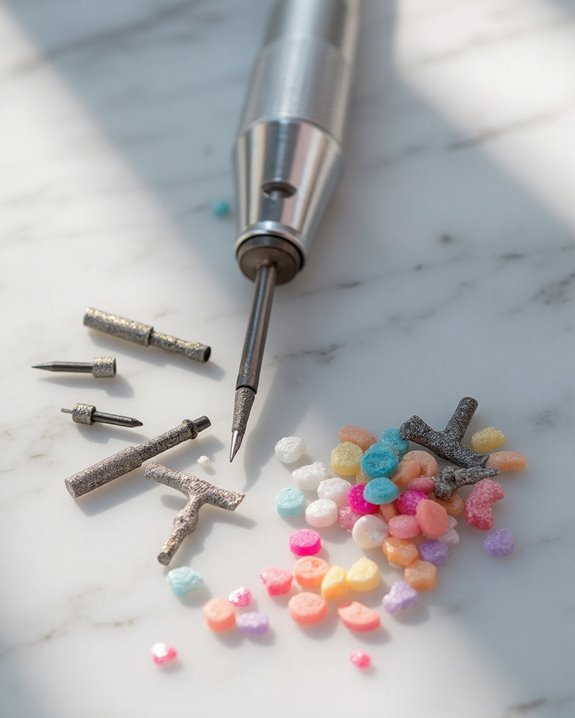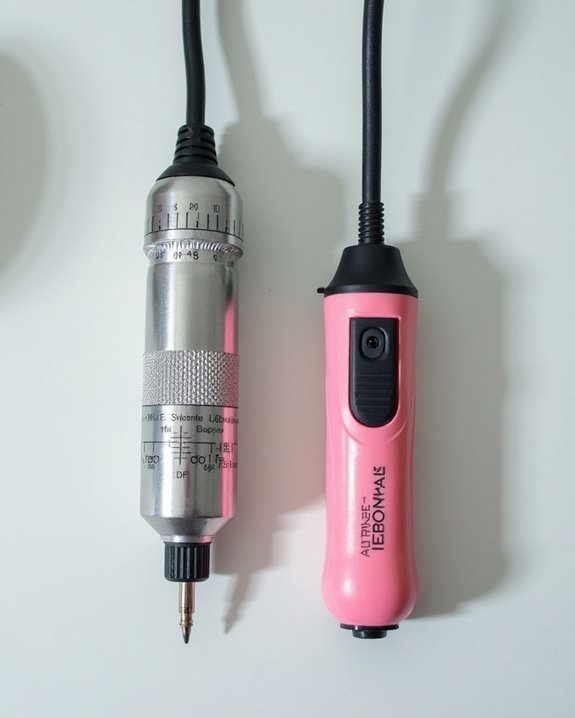Selecting the right nail drill requires consideration of key technical specifications. Professionals should seek models with at least 30,000 RPM and 30V power for effective product removal, while beginners may start with 25,000 RPM options. Look for lightweight, ergonomic handpieces that reduce fatigue and standard 3/32-inch bit compatibility for versatility. Price points range from $30 for basic models to $100+ for professional units with advanced features. Further exploration reveals important distinctions between home and salon-grade equipment.
Key Takeaways
- Select drills with over 30V for effective product removal and reliable performance.
- Choose devices with 30,000-35,000 RPM capacity for efficient professional work.
- Prioritize lightweight, ergonomic handpieces to prevent hand strain during prolonged use.
- Ensure the drill accepts standard 3/32-inch shank bits for maximum compatibility.
- Consider your budget alongside features, with professional-quality options available between $30-$100.
Understanding Electric Nail File Power Requirements
Why do professional nail technicians often emphasize voltage when discussing nail drills? The answer lies in the direct relationship between voltage and performance effectiveness. Unlike common misconceptions, an electric nail file’s power measurement in volts determines its ability to remove products efficiently, not its rotation speed.
Technicians should select nail drills with power exceeding 30 V, as models operating at lower voltages (15 V or 20 V) frequently deliver inadequate results during product removal procedures. The power specifications, clearly indicated on devices or in accompanying technical documentation, serve as critical selection criteria for professionals seeking reliable performance. An adjustable speed nail drill with appropriate voltage guarantees consistent effectiveness across various applications, from basic manicures to complex refills, making voltage verification an essential step before investing in professional equipment.
For optimal compatibility, it’s important to verify the voltage range when replacing cords for Kiara Sky nail drills to ensure they match the device’s specifications of 12V-24V.
Essential Speed and Mode Features to Consider

The key to selecting an appropriate nail drill extends beyond voltage considerations to include essential speed and directional capabilities that greatly impact performance. The best nail drills offer forward and reverse modes, allowing technicians to work forward and reverse in different directions without holding their hands or the client’s in awkward positions during manicures and refills.
Speed range is equally vital, with beginners finding 25,000 RPM sufficient for basic tasks like poly gel removal, while professionals require 30,000-35,000 RPM for efficient carving and shaping. A minimum capability of 30,000 RPM guarantees effective product removal, unlike lower-powered 15V or 20V models that may struggle with this task. High-end models offering up to 35,000 RPM, such as the Stephanee, provide the flexibility needed for various nail applications, similar to adjusting a vehicle’s speed for different terrains.
Lavinda models, for instance, deliver up to 35,000 RPM for handling tough acrylic nails effectively.
How Handpiece Design Impacts Comfort and Performance

When selecting a nail drill, handpiece design stands as perhaps the most critical factor influencing both comfort and performance during nail services. Lightweight handpieces are essential because heavy models create significant strain on hands and wrists during extended sessions. If a handpiece is too heavy, you won’t be able to work efficiently, and wrists will hurt after prolonged use, potentially leading to repetitive stress injuries.
Ergonomically balanced handpieces, like the MelodySusie Portable Electric Nail Drill, offer superior control and reduce fatigue. Models with low vibration and minimal heat generation further enhance precision and comfort, allowing technicians to complete intricate details without compromising accuracy. Professional nail technicians should prioritize handpieces weighing below the threshold that causes discomfort, as this directly impacts their long-term productivity and physical well-being during manicures and refills. Additionally, incorporating heat dissipation technology in handpiece designs helps prevent overheating and protects sensitive nail beds during extended use.
Bit Compatibility and Material Options

Understanding bit compatibility and material options represents a foundational aspect of nail drill selection, directly impacting both a technician’s efficiency and service quality. The standard 3/32-inch shank size guarantees maximum compatibility across professional electric files, while non-standard sizes like 1/8 inch can limit available options.
Drill bits come in a variety of materials, each serving distinct purposes. Carbide bits, available in gold or silver variants, offer exceptional durability for heavy-duty acrylic removal. Ceramic options reduce heat build-up during operation while simplifying sterilization processes. Metal or rubber mandrel bits accommodate interchangeable sanding bands in various grits for versatile surface preparation. When selecting bits, technicians should consider grit classification—coarser grits with larger particles tackle aggressive removal tasks, while finer grits with shallow flute cuts provide precision finishing on delicate nail surfaces.
Price Points and Value Assessment for Different Skill Levels

Selecting a nail drill at an appropriate price point represents one of the most impactful decisions in a technician’s purchasing process, directly influencing both immediate satisfaction and long-term value. The market offers options spanning from $10 to over $250, with quality considerations establishing $30 as a reasonable entry point for beginners. This threshold provides adequate functionality without overwhelming new users with advanced features.
Professionals should invest in models between $30-$100, which deliver higher RPM capabilities (30,000-35,000) necessary for efficient acrylic and gel removal. This investment rationale extends beyond the upfront cost, as higher-quality drills typically offer improved durability and performance over several years. The professional calculation must consider time savings per client, where a superior nail drill potentially increases daily appointment capacity and revenue generation.
Key Features for Professional vs. Home Use

The critical divide between professional and home-use nail drills manifests through several distinctive feature sets, each tailored to specific usage environments and operational demands. Professional models typically offer higher performance specifications, with RPM capabilities reaching 35,000 for efficient acrylic removal, while home units generally top out at 25,000 RPM for basic maintenance tasks.
For the professional nail artist, hands-free operation often comes with a foot pedal, as exemplified by the Geneviere model, enabling uninterrupted workflow during extended salon sessions. Conversely, Portable Nail drills designed for home use, like the Stefy, emphasize rechargeable batteries with four-hour lifespans and compact designs that sacrifice base stations for mobility. Professional units also prioritize reduced vibration and noise levels for precision work, whereas home models feature user-friendly variable speed controls suitable for beginners.
Frequently Asked Questions
How to Choose the Right Nail Drill?
Like a masterful artist’s tool, the perfect nail drill emerges through research. One should examine drill brands, consider price range from $30-$100, and prioritize ergonomic design for comfort during extensive use sessions.
How Powerful Should a Nail Drill Be?
A powerful nail drill should offer 30+ volts with 25,000-35,000 RPM depending on experience level. Motor torque affects performance on hard materials, while energy efficiency and battery life determine portability and continuous operation capabilities.
What Speed Should My Nail Drill Be On?
Nail drill speed depends on experience and materials. Beginner speed (18,000-25,000 RPM) suits newcomers. Safety speed for natural nails stays under 15,000 RPM. Material speed varies: acrylics require at least 25,000 RPM, while gel needs moderate settings.
What RPM Nail Drill Do Professionals Use?
Like chariots of old, professional nail technicians harness drill power at 30,000-35,000 RPM for efficiency. Professional RPM ranges prioritize precision for complex tasks, while RPM safety considerations guarantee proper control. RPM comparisons show higher speeds save time.





